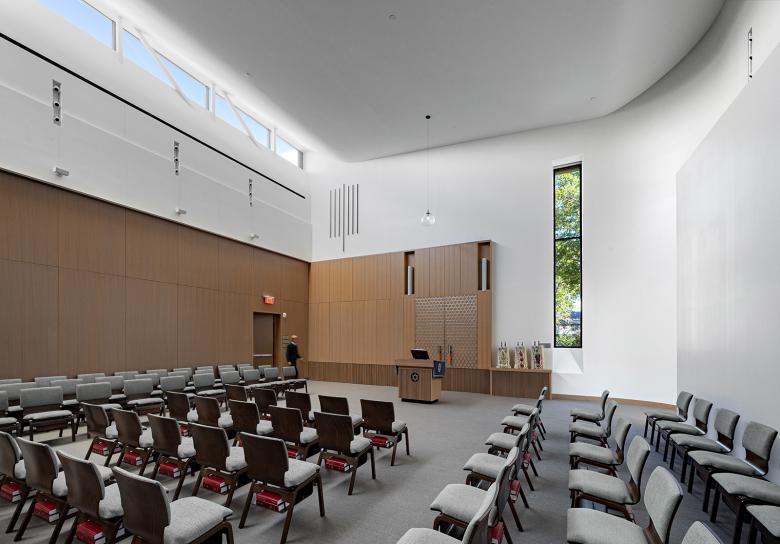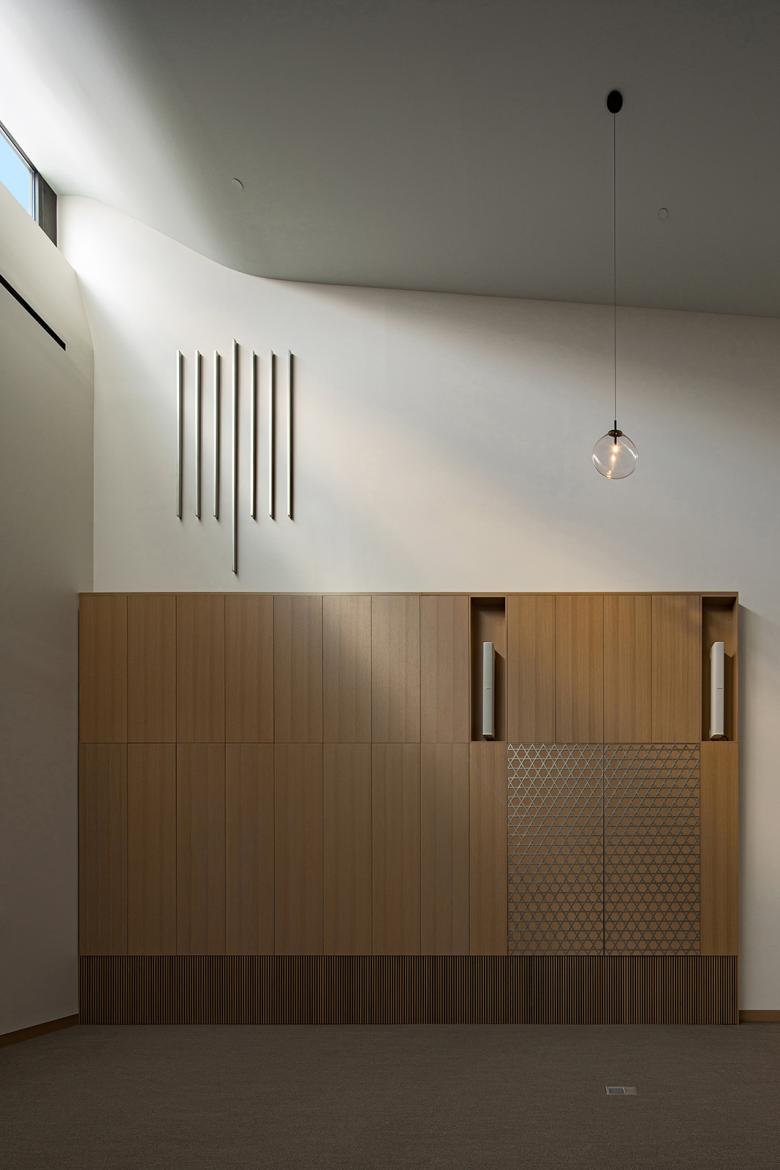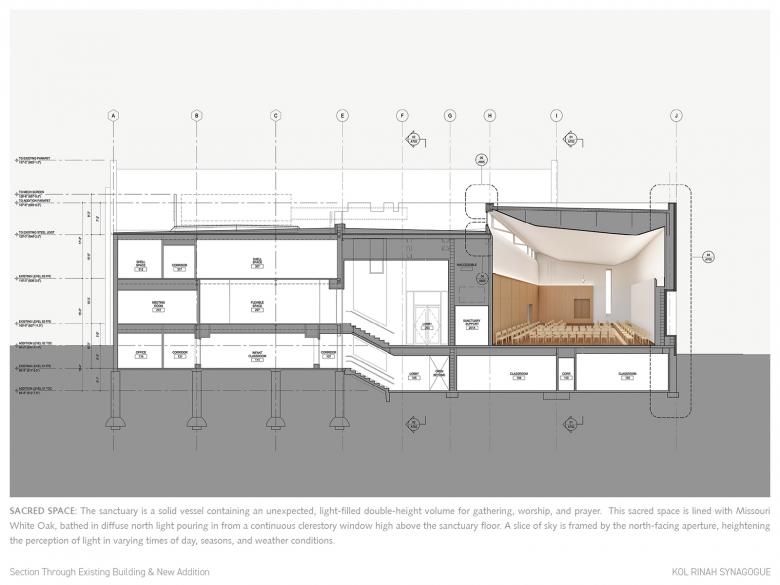US Building of the Week
Kol Rinah Synagogue
Patterhn Ives
14. fevereiro 2022
Photo: Sam Fentress
Kol Rinah Synagogue is located on the edge of Downtown Clayton, a busy business district just west of St. Louis, Missouri. A new addition, designed by Patterhn Ives, houses the sanctuary in a box that is limestone outside, oak inside. Partner Anna Ives answered a few questions about the project.
Location: St. Louis, Missouri, USA
Client: Kol Rinah
Architect: Patterhn Ives
- Design Principal: Anna Ives
- Project Team: Eric Hoffman, Tony Patterson, Gwen Arenberg, Megan Griffith, Jason Ward
MEP/FP Engineer: McClure Engineering
Civil Engineer: Civil Design, Inc
Landscape Architect: Ten x Ten Studio
Lighting Designer: McClure Engineering
Interior Designer: Patterhn Ives
Acoustics: Kirkegaard Associates
Kitchen Consultant: Dennis G. Glore, Inc
Cost Estimating: Everest Estimating Services
Contractor: Phase 1: Lawlor Corporation; Phase 2: ISC Contracting; Phase 3: BSI Constructors, Inc
Specialty Fabrication: Mademan Design, Troco Custom Fabricators
Landscape Construction Administration: Arbolope Studio
Site Area: 1 acre
Building Area: 32,000 sf (renovation), 8,700 sf (addition)
Photo: Sam Fentress
Please provide an overview of the project.Two established Jewish congregations are unified on a property that previously served as a Baptist church and school. A new limestone addition containing sanctuary and entry is precisely positioned within an urban garden to create a dynamic environment for this diverse and inclusive community serving three primary functions: Gathering, Learning, and Prayer.
The project includes an 8,700-square-foot expansion with a new accessible entry and arrival space, elevator, and a double-height sanctuary fostering contemplation and spirituality through a careful composition of acoustics, material, and natural light.
The 1950s church and school buildings are transformed into a new flexible social hall, religious education classrooms, small chapel, administration and support spaces. The full lower (garden) level is home to Kol Rinah’s vibrant Early Childhood Center including new classrooms with indoor and outdoor play spaces.
Photo: Sam Fentress
What are the main ideas and inspirations influencing the design of the building?The outward character of the site and the building was an early driver. A welcoming and inclusive sensibility needed to be balanced with humility and security. The stone mass of the addition is intentionally quiet, seeking beauty and eloquence with an economy of means.
Spatial experiences focus on natural light, material, and acoustics. The sanctuary is a sacred space lined with Missouri White Oak, bathed in diffuse light pouring in from a clerestory window high above the floor. Ambient illumination allows this space to function during most daytime hours without artificial light.
Acoustically, the sanctuary is tuned for speech and vocal music. Primarily constructed as a masonry mass for isolation, the interior is shaped with subtly angled walls and a sculpted ceiling, which interact with carefully located absorptive treatments to create a quiet space that supports clear communication, fellowship, and contemplation.
Photo: Sam Fentress
How does the design respond to the unique qualities of the site?From the very beginning we understood the unique potential of this site as an urban garden: an elevated green space with views south through an existing row of mature trees, at the edge of a growing business district. The addition is positioned to create a new entry and accessible approach from the west, while framing a new courtyard, or "outdoor room" to the east, becoming the heart of the Synagogue as a whole.
The materiality of the addition emerged from the limestone trim of the existing church and school buildings, as well as several adjacent stone structures. The newly created intervention completes the site through form and material, seeking a timeless spirit of place with resonance between tradition and modernity.
Photo: Sam Fentress
How did the project change between the initial design stage and the completion of the building?The project began by designing all program components for the renovation and addition, including site and landscape that had numerous constraints for building setback, existing mature trees, stormwater, parking, accessible entry, services, Early Childhood drop-off and outdoor play spaces.
To meet a restrictive budget based on project fundraising, an extraordinary amount of work was initiated to break the project into smaller bid packages for construction, each with a different contractor. Phase 1 included the building addition and primary floor level renovations for the Synagogue; Phase 2 was dedicated to upper level renovations for Synagogue administration; and Phase 3 lower level renovations for the Early Childhood Center.
Through multiple phases of construction, the design proved malleable, shifting as needed to accommodate nuanced schedules, budgets, and existing conditions. The project was an amazing test of our assertion that architecture is the elegant resolution of complex influences.
Photo: Patterhn Ives
What products or materials have contributed to the success of the completed building?We believe the way a building is detailed has lasting impact on the lives of those who experience it. From how people see and understand structure to composing materials that tell a story, we are intensely committed to craft. In this case, we rigorously researched limestone, traveling to quarries and engaging with stone masons. We are interested in drawing from vernacular and traditional techniques to understand and possibly reinterpret, telling old stories in new ways.
The limestone cladding of the addition absorbs and reflects light in a very distinct way, giving the surfaces unique visual qualities depending on varying light and weather conditions. The stone is regionally sourced from the Flint Hills in Kansas. It’s warmth, variation, and natural occlusions reveal geologic time and an embedded history of place.
Lighter toned two-foot-by-six-foot panels are set in contrast to darker toned six-inch-by-six-foot panels. Control joints are carefully concealed. Tooled mortar joints ease the surface, exhibiting the hand of the mason. Natural stone helps connect the Synagogue to its place, imparting civic presence and permanence.
Email interview conducted by John Hill.












